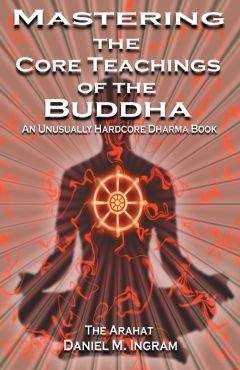Daniel Ingram - Mastering the Core Teachings of Buddha - An Unusually Hardcore Dharma Book
На сайте mybooks.club вы можете бесплатно читать книги онлайн без регистрации, включая Daniel Ingram - Mastering the Core Teachings of Buddha - An Unusually Hardcore Dharma Book. Жанр: Прочее издательство -,. Доступна полная версия книги с кратким содержанием для предварительного ознакомления, аннотацией (предисловием), рецензиями от других читателей и их экспертным мнением.
Кроме того, на сайте mybooks.club вы найдете множество новинок, которые стоит прочитать.

Daniel Ingram - Mastering the Core Teachings of Buddha - An Unusually Hardcore Dharma Book краткое содержание
Mastering the Core Teachings of Buddha - An Unusually Hardcore Dharma Book читать онлайн бесплатно
Do you cycle naturally through the cycles of insight from stage four to eleven and then attain Fruition? If you just sat down on a cushion and did nothing special, would you move through these stages as easily as falling down a hill? Do Fruitions arise after such cycles in a way that fairly consistently leaves you with the staggering impression that, “that was it!”? If not, I would avoid harboring any notions that you are enlightened, “have been enlightened some time in the past,” etc., as you are almost certainly in error. Such notions are not helpful most of the time anyway, and tend to be bound up in a sense of solidity and imagined continuity of self that is simply unrealistic.
I have a friend who erroneously thinks he is enlightened and once said, “Oh, yes, I went through those stages once many years ago, but now I am beyond them.” Toast! Those who are enlightened go through these stages hundreds if not thousands of times each year. There is absolutely no getting around them barring deep sleep, severe brain damage, strong sedation or death.
However, it is fair to mention that some enlightened people simply don’t think about things in this way, have never noticed that they cycled, never picked up on the patterns, were never exposed to the maps, don’t have particularly strong concentration, don’t realize how they got there, are not particularly intellectual or, if they are, never applied their intellect to these aspects of where theory meets practice, never really paid attention to the way things unfold, and couldn’t care less. Thus, if someone is enlightened, I brazenly assert they cycle like this, but that doesn’t mean they realize they do, and if their practice unfolded gently or slowly or without very intense concentration and a map-oriented focus, they may have no idea about most of the things I am discussing here and yet they apply to them anyway. I poured massive amounts of energy into my practice, developed very strong concentration, and care about the maps obsessively, but that doesn’t mean that other beings who are enlightened did or do.
250
“Was That Emptiness?”
Back to describing the cycles. As Review sets in, it can seem that one can control these cycles and stages. It may seem after we have mastered a path somewhat that we can call insight stages up in order and stay in them as long as we wish or even call them up out of order. From one point of view, enlightened beings can master and manipulate the stages of insight, though such practices can take on much more of a samatha feel than an insight feel. From another point of view, perhaps a more thoroughly insight-oriented point of view, even such a notion is erroneous. Stages, cycles, and the empty intentions to manipulate them occur in a causal fashion, and if there is a sense that there is an independent self that is controlling them, then there is obviously more work to do. Now, there’s a high standard, and worthy standard, indeed!
These cycles, as with everything else, simply belong to the nature of things.
251
Mastering the Core Teachings of the Buddha
29.BEYOND FIRST PATH (“WHAT NEXT?”)
Obviously, it can be easy for a meditator to think that they have completed a progress of insight and gotten stream entry when in fact they haven’t. It is also possible for a meditator to have actually completed a progress of insight and yet think otherwise, but this is much less common. Sometimes a student will be correct in thinking that they have, but their teachers will remain unconvinced. Sometimes a teacher may think that the student has and yet be wrong. Regardless, just keep practicing and see what happens. This is the most fundamental principle for all of these stages. A particularly useful and traditional guideline is to wait a year and a day before completely making up your mind. This is slippery stuff sometimes, and many states and stages can easily fool a student or teacher into thinking that they are something they are not.
When a meditator successfully completes a progress of insight, they have permanently debunked certain illusions to some degree, but many remain. These tend to include a new fascination with the understanding that has arisen from that path. However, if one’s “realization” doesn’t stand to the test of time, or if there is not some sort of fundamental and unalterable reduction in suffering, write it off and keep going. Even if one does complete a progress of insight, is easy to imagine that more has been debunked than actually has, so continue to practice training in morality throughout your life as before to avoid being bitten by those unskillful potentials that remain but are hidden. Strangely, the temptations to screw up can become more subtle and seductive as practice deepens. These tend to be at their worst around the next Arising and Passing Away or during the next Re-observation.
An extended series of progresses of insight tend to proceed as follows. They may be called “Paths” in the Theravada and “Bhumis” in the Tibetan, though there are some problems that arise in trying to resolve the inconsistencies in these two models that will be touched on a bit later. Thus, a more general treatment follows, and the descriptions of the stages here are not taken directly from any particular tradition. From one point of view, all of this is not necessary information, as continued practice just as before will continue to move things along quite naturally.
On the other hand, if one has expectations about what might come next
Beyond First Path (“What Next?”)
that are not in accord with reality or interfere with practice, then this information might be helpful.
The meditator masters this stage of awakening by continued practice as before. They can quickly learn to rise through all of the stages, starting from the Arising and Passing Away, through the Dark Night, up to Equanimity and Fruition in a single sitting or even during some of the activities of daily life. Merely sitting down on a cushion, or being awake for that matter, will involve naturally moving through these cycles, thought the speed and clarity of these can vary widely depending on the practitioner and circumstances. They may even find it interesting to purposefully hang out in some of the stages of the Dark Night just to learn more about them and from them, as they have some very
important lessons to teach and are very interesting territory. However, they may also come to realize that this is really just a new beginning in some ways, sort of like graduating from high school but then becoming a lowly freshman in college.
The period after completing a progress of insight and after gaining some strong sense of mastery of its stages is also a great time to work on one’s concentration practice abilities. The reason for waiting is that concentration practices and insight practices tend to have a certain inertia to them. If you have recently been trying to get into really stable samatha states, this can make it harder to see things flicker for a while. If you have recently been training hard to see things flicker, it can be hard to get into really stable samatha jhanas. Thus, what you don’t want to do is to gunk up the natural mastery phase of your practice until you are comfortable enough with these stages to get stuck in one and not have it be a big deal. This usually takes at least a few weeks, but this is a very crude guideline, and everyone is different regarding issues of timing.
Judge for yourself how well you handle stages such as Re-observation and decide if you would be alright if you got stuck in it for a few hours.
The time after gaining some mastery of these stages is also a great time to work on one’s stuff. Actually, doing concentration practices and working on one’s stuff go very well together, as concentration states tend to cause our stuff to come bubbling to the surface where we can work with it. The time during a mastery phase is also a great time to make 253
Beyond First Path (“What Next?”)
sure that one’s daily life is functioning well, particularly if one made a mess of it while trying to get enlightened or more enlightened.
Mastery of these stages tends to peak at some point, and the sense can arise that one has really “got it.” Fruitions tend to occur fairly quickly, clearly and easily. Given time and practice, they may begin to become somewhat bored with their current level of attainment and with their ability to attain these stages and Fruition. Their practice can begin to seem sloppy, and the quiet bliss wave after Fruition can diminish somewhat unless they do not attain it for some long period of time (which would probably require resolutions to that effect).
The understanding that there is more suffering to uproot grows.
They begin to see more levels of reality that are clearly not well understood or illuminated by their current understanding, hints of which probably showed themselves very soon after their attainment of that path. Subtle thoughts and mental patterns may be noticed at the edge of one’s perceptual threshold. Attention begins to incline towards the next level of reality that must be understood and away from familiar territory. More fresh insights begin to show up.
They begin to investigate reality with more effort and clarity as before and begin a new progress of insight from the beginning, i.e.
access concentration and then Mind and Body and the rest. This might play out as follows: fairly soon after the sense of strong mastery, one will simply be meditating along, perhaps a Fruition will occur, and then suddenly the mind drops into this new state rather than a new review cycle beginning again. It is stable, interesting, and somewhat jhana-like.
It is sort of like re-inhabiting one’s life or reconnecting with the sense of the observer. It is also likely the next Mind and Body. This could also happen when one was just going about one’s day.
The postural obsession, odd movements, strange tensions and
pains, emotional volatility, vibratory stuff that seems new, a fresh and clearer sense of what dualistic perspectives remain, and all of the other early progress of insight stuff may arise in its time naturally and perhaps sooner than one might wish. The phrase “leading onward” is often used to describe the wisdom that arises from dharma practice. Strangely, it is a phrase and a fact that I have cursed just as often as blessed, and entering new insight territory at inopportune times or before one feels 254
Beyond First Path (“What Next?”)
ready can reveal why. Insight cycles can sometimes be very traumatic, and it is often advisable to take a break to recover one’s sense of humor and appreciation of life before plunging on. However, at this point the dharma waits for no one and may plunge on regardless of your wishes.
Note well, for those in between stages, there initially is still the ability to easily attain any of the previous stages starting at the level of the current Arising and Passing Away, so things can get quite murky if they are trying to figure out what stage they are in or attain specific new stages. It can be as if the early stages are opening up to us, whereas for a while things always started out at the level of the Arising and Passing away.
Fixating on thoughts about what stage you are in is guaranteed to cause some degree of suffering that is worthy of investigation, especially in the in between stages, though a gentle awareness of the maps can still be slightly useful. There can be a sort of a fork in the path for a while, with the meditator seemingly being able to choose whether to review previous stages or press on. It can seem as though the background is solidifying and the mind is growing nosier as well as less predictable and skillful. More of our stuff is suddenly bubbling up to the surface. We notice subtler thoughts and mental images, many of which we may wish we hadn’t. We may feel less “enlightened,” as if our realization were fading. Clear and consistent insight practice, i.e. understanding the Three Characteristics of all types of sensations, which includes thoughts of maps and goals, is the only thing that finally helps, just as before.
After the meditator crosses the next Arising and Passing Away Event, which may happen relatively quickly if they practice well and often, they will tend to have a very hard time re-attaining Fruition for a while. One may meditate along and then get stuck in a stage that seems to lead nowhere and is sort of like low equanimity, in that there are clear vibrations that are not varying with the breath or any other movement, and yet the background is too dense, noisy and poorly perceived for clear and complete formations to show themselves.
Finding the proverbial fork in the road to familiar territory can now be quite tricky, and even if they do find the way back, the old territory is unlikely to be particularly appealing. Old Fruitions may arise, but they may do so in a way that is less reliable or certain. Suddenly, the 255
Beyond First Path (“What Next?”)
meditator is “on the ride” again, and will soon have to face the fullness of the next Dark Night with all of its implications. It may even be more challenging than before, but could just as easily be less so. One friend of mine sailed through one Dark Night in about six minutes, and the next one took him many years. There is no predicting these issues of timing.
It can happen that many times they will try to meditate to
equanimity but fall back when they get to Re-observation. They may thus try to re-attain previous stages, as they may feel in over their heads.
They may get into the next stage of Desire for Deliverance, wish very strongly to go beyond all of this, and do so by re-attaining to a Fruition of the current path instead of attaining the next one.
However, even if they are able to retreat into the old territory, they will still be haunted to some degree by the Dark Night in their life and will have to learn to navigate skillfully in this territory one way or another. Sometimes re-mastering the current path is helpful for building a sufficient foundation from which to proceed well into the new territory. Eventually, there is no way to go back, and one is simply left facing the new territory without an obvious skillful escape route.
There can arise an odd phenomenon that has been referred to by one of my teachers as “Twelfth Path,” though this phrase is not in common usage. It is, however, a common phenomenon in those who have attained at least stream entry and is probably the most important concept in this book for those working on the higher paths, particularly beyond second path. Twelfth Path is making a joke about the fact that there are at most four stages of enlightenment in the Theravada map and five or ten in the Tibetan maps. However, it can easily seem that more than ten brand-new and full-blown cycles of insight have been completed and yet there is still much more to go. If one is going to get obsessed with the fractal model that I mentioned earlier, it is likely to happen around here. Unfortunately, the fractal model is even more useless now than it was earlier, and so I strongly recommend avoiding it like the plague if you think you are in a new progress cycle rather than a review cycle.
Things might proceed as follows. It seems certain that a cycle has been completed. Next, there seems to be a clear mastery stage that withstands all of the most rigorous tests, then more early progress of 256
Beyond First Path (“What Next?”)
Похожие книги на "Mastering the Core Teachings of Buddha - An Unusually Hardcore Dharma Book", Daniel Ingram
Daniel Ingram читать все книги автора по порядку
Daniel Ingram - все книги автора в одном месте читать по порядку полные версии на сайте онлайн библиотеки mybooks.club.




